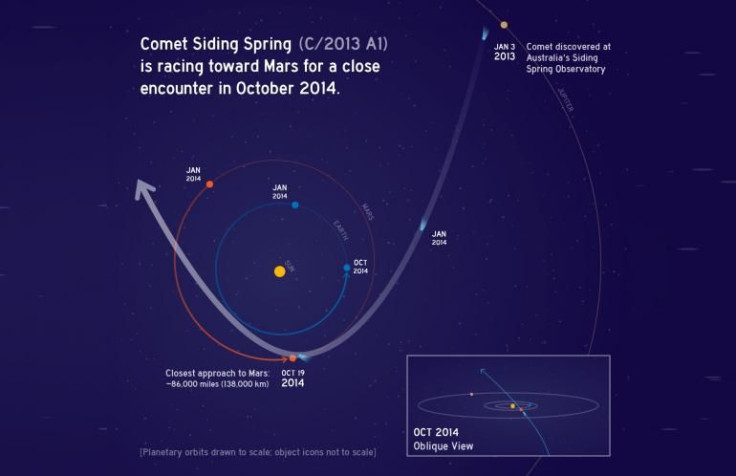Siding Spring Comet Approaches Mars: 5 Facts About The Extraterrestrial Traveler

A comet, dubbed “C/2013 A1 Siding Spring,” is gradually approaching Mars for an extremely rare and close flyby around the red planet on Oct. 19. The comet's approach has prompted NASA to shelter its Mars orbiters and rovers from the encounter, which is likely to put on a “barnstorming show” on the planet.
The comet, which was discovered by an Australian comet hunter named Robert H. McNaught on Jan. 3, 2013 at the Siding Spring Observatory in New South Wales, Australia, will pass by Mars on Oct. 19 at a distance that is 10 times closer to the planet's surface than any identified comet has ever flown past Earth. At the time of its discovery, Comet Siding Spring was farther from the Sun than Jupiter is, and was about 7.2 times farther away from the sun than Earth, according to NASA.
Here are five facts about Comet Siding Spring, a first-time visitor from the Oort Cloud -- a hypothetical spherical cloud of icy objects nearly a light-year away from the sun.
Not The Only One Named Siding Spring
The comet is not the only one with Siding Spring in its name. But, it is differentiated from other similarly-named comets with the official prefix, “C/2013A1,” which indicates that it was the first long-period comet discovered in 2013. McNaught discovered the comet in the constellation of Lepus, as it was flying inward, beyond the orbit of Jupiter.
Kicked Out Of Oort Cloud
The comet C/2013 A1 Siding Spring had been swarming with other comets in the Oort Cloud at the edge of the solar system for billions of years, before a “gravity-based shake-up” directed it toward Mars. Kicked out of the Oort Cloud, the comet has travelled for more than one million years to get to Mars, on its first journey toward the sun.
No Crash!
Although the comet is unlikely to crash into Mars, the planet is expected to pass through its coma of gas and dust. Scientists say that if the comet is active during its close encounter with Mars, the rovers on the planet could witness a meteor shower similar to the annual Leonid shower on Earth.
“We don't have enough information yet to define the coma's size, but we do know it is likely to engulf all of Mars,” a NASA statement said.
Fast-Flying Particles Won't Damage Rovers
According to scientists, when C/2013 A1 Siding Spring’s coma will surround Mars, dust and other particles within the trail will be traveling at a speed of 125,200 miles an hour, or about 35 miles a second, which is nearly 50 times faster than a bullet fired from a high-powered rifle.
“The Martian atmosphere, thin as it is, is dense enough to prevent incoming dust from the comet from becoming a hazard to NASA's two Mars rovers active on the surface,” NASA said.
The Return
According to scientists, the orbital period of C/2013 A1 Siding Spring has yet to be determined, so its return to the inner solar system cannot be predicted now. However, it is believed that the comet is not likely to make a comeback for another million years.
© Copyright IBTimes 2025. All rights reserved.






















